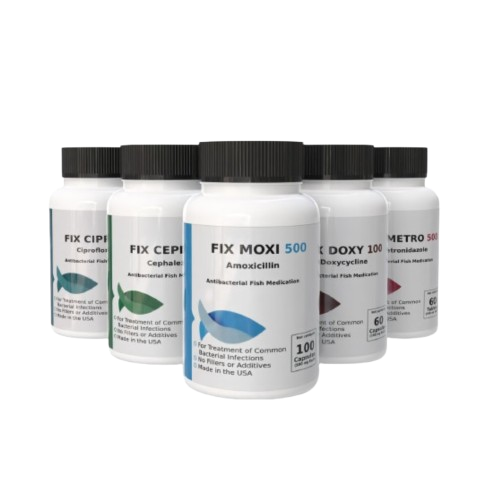Posted by Aquatic Veterinary Specialist on 14th Apr 2025
How to Treat Ich on Freshwater Fish: Symptoms, Causes & Complete Cure Guide
How to Treat Ich on Freshwater Fish
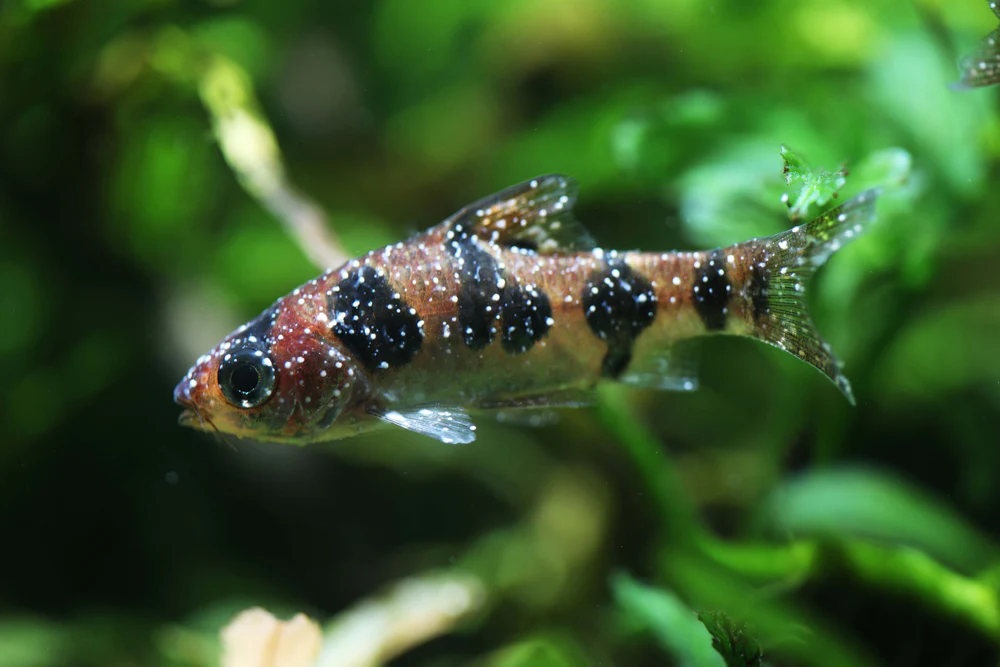
Ich (short for Ichthyophthirius multifiliis) is a common parasitic disease in freshwater aquarium fish that appears as tiny white spots on the fins and body – as seen on the cichlid above. Also known as “white spot disease,” ich is caused by a protozoan parasite that burrows into a fish’s skin and gills. Infected fish often rub against objects (as if scratching an itch) and may become lethargic due to irritation. Without prompt treatment, fish ich can spread quickly and even be fatal in a fish tank. This comprehensive guide explains what ich is, the signs of ich in fish, the parasite’s life cycle, and most importantly how to treat ich in fish (and how to cure ich in a fish tank for good). We’ll also cover prevention tips to keep this pesky parasite out of your aquarium.
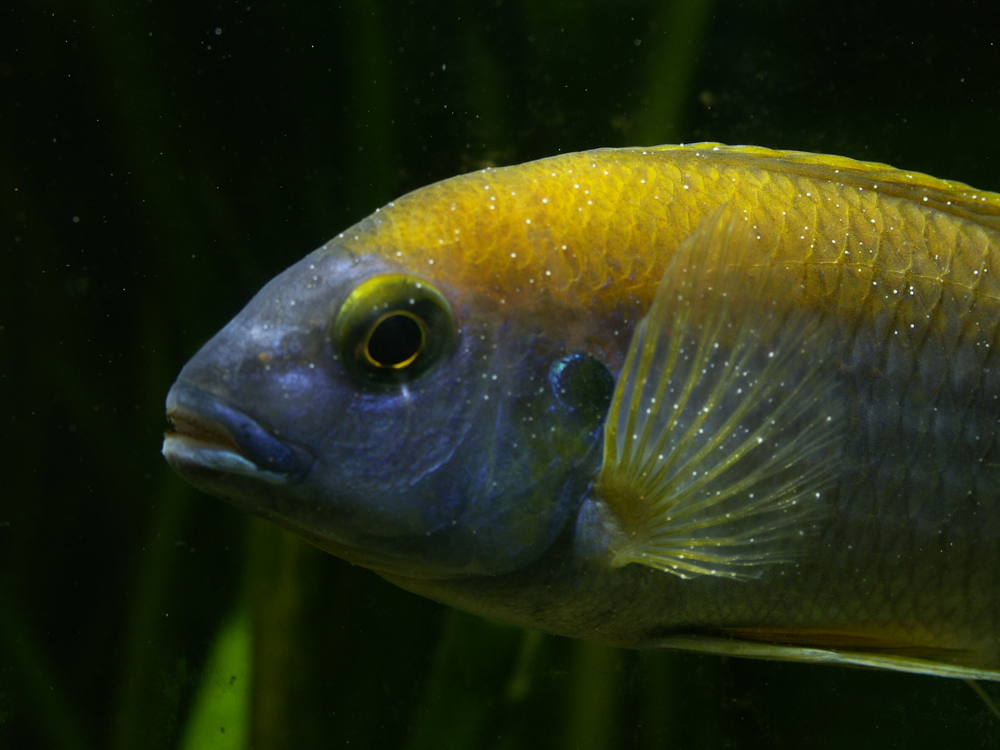
What is Ich in Fish?
Ich is a parasitic infection in fish caused by the single-celled ciliate Ichthyophthirius multifiliis. Under a microscope it looks like a oval ciliate protozoan, but to the naked eye it appears as white specks on the fish. Each white spot is actually a trophont – the feeding stage of the parasite embedded under the fish’s mucus layer and skin. Ich outbreaks are easy to recognize because infected fish look like they’ve been sprinkled with salt or sugar grains on their body and fins. The disease is so well-known it’s simply called “ich” (pronounced “ick”) by aquarists, and it’s one of the most common ailments in freshwater aquarium fish.
What causes ich in fish? The direct cause is exposure to the ich parasite. It does not arise spontaneously – your fish get ich when this parasite manages to enter your tank. In practice, this often happens by introducing new fish that carry ich cysts or theronts (free-swimming parasites) into the aquarium. Many fish can carry a small, latent infection of ich without showing symptoms until stress or poor water conditions allow it to flare up. Failing to quarantine new fish is the most common reason aquarists suddenly find ich in a fish tank. In addition to new fish, Ichthyophthirius can hitchhike on live plants or contaminated equipment (nets, siphons, etc.) that came from an infected tank. Even water transferred from an infected aquarium or pond can introduce the parasite. Once a single ich organism enters a tank, it can reproduce rapidly and spread to every fish in the aquarium.
Ich is highly contagious among fish, but it is species-specific – it won’t infect humans or other pets, only fish. Almost all freshwater fish species are susceptible, from guppies and goldfish to angelfish and oscars. Early signs include a few white spots and mild scratching, but a severe ich infestation can overwhelm a fish’s gills and skin, leading to difficulty breathing, secondary infections, and death if not treated. Fortunately, ich can be cured with diligent treatment. The key is to understand the parasite’s life cycle and attack it at its vulnerable stage.
Life Cycle of the Ich Parasite
Understanding the life cycle of ich is critical to beating it. Ichthyophthirius multifiliis has a complex life cycle with multiple stages, and each stage behaves differently:
-
On-Fish Stage (Trophont): This is the stage when the parasite is embedded in the fish’s skin or gills, visible as a white spot (each spot is a single trophont). The trophont feeds on the fish’s tissues, growing up to ~1 mm in size under the skin. At this stage the parasite is protected by the fish’s skin and mucous, which makes it resistant to direct treatment – medications cannot kill ich when it’s under the fish’s epidermis.
-
Cyst Stage (Tomont): After feeding for several days, the mature trophont leaves the fish. It drops off into the aquarium water and attaches to a surface (gravel, plants, glass, filter) and encysts itself in a tough gelatinous coating – now called a tomont. Inside this cyst, the parasite undergoes rapid cell division, splitting into many new individuals (typically hundreds of daughter cells). In fact, a single tomont can produce up to 1,000 theronts (baby parasites), depending on temperature. The tomont stage is also insulated from treatment by its cyst wall; most medications can’t penetrate it.
-
Free-Swimming Stage (Theront): Within the cyst, the dividing cells mature into tiny ciliated swimmers called theronts. These then burst out of the cyst into the water column. Theronts are microscopic and invisible to the naked eye, but they are the infective stage – they swim in the water actively searching for a fish host. This is the only stage of ich that is vulnerable to treatment, because the theronts are exposed in the water. If a theront finds an uninfected fish, it will invade the fish’s epidermis (often entering the gills or skin) and develop into a new trophont, thus starting the cycle over. If a theront cannot find a host fish within a short time (usually about 1–2 days), it will die, which is why leaving a tank empty of fish can clear an ich infestation.
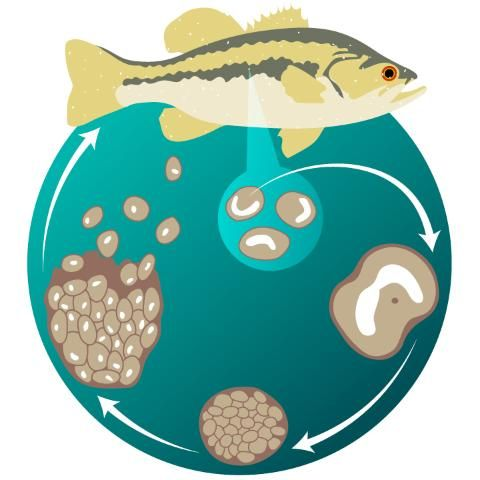
One important aspect of ich’s life cycle is how strongly it’s influenced by water temperature. The parasite’s development speeds up in warm water and slows down in cold water. For example, at about 25°C (77°F) the entire cycle (from trophont to tomont to theront and back to trophont) might complete in around 1 week, whereas in cooler water of 6°C (~43°F) it could stretch out to 6–8 weeks. In tropical aquariums (mid-70s to 80°F range), ich typically cycles fast, which is why an outbreak can seem to explode in just a few days. The good news is that warmer temperatures also shorten the time theronts spend free-swimming, which gives a narrower window during which you can kill them. In contrast, in a coldwater tank or pond, ich can lurk for a long time in the tomont stage. (Many goldfish keepers know that ich can overwinter in a pond and then bloom when temperatures rise.)
Implications for treatment: Because ich can only be killed easily in the free-swimming theront stage, any effective ich in fish treatment must be maintained through the full life cycle to catch all parasites as they become free swimmers. This is why treating ich isn’t a one-time thing – you have to continue medication or treatment for several days after you last see spots on the fish. Stopping too early means some tomonts or theronts could survive and re-infest the fish. In the next section, we’ll cover how to treat ich in fish by targeting these vulnerable stages and breaking the parasite’s cycle.
Signs of Ich in Fish
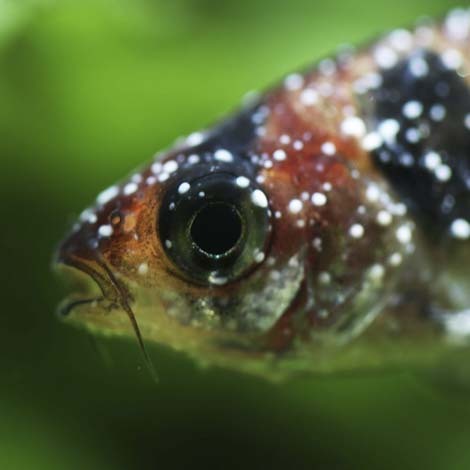
How do you know if your fish have ich? The disease has some very distinct signs. The most obvious is the white spots on the fish’s body, but there are also behavioral changes as the fish react to the irritation. Here is a comprehensive list of signs of ich in fish to watch for:
-
White spots on the body and fins: Small white dots (about 0.5–1 mm across) visible on the fish’s sides, fins, and sometimes eyes. They often look like grains of salt or sugar granules sprinkled on the fish. These spots may start on just a couple of fish or in just a few areas, but can rapidly spread to cover large portions of the fish as the parasite multiplies. (Do note that white spots on gills are harder to see, but heavily infected fish may show rapid breathing as a clue.)
-
Flashing or rubbing behavior: Infected fish commonly scratch themselves against objects in the tank – you’ll see them dashing, rubbing, or “flashing” on gravel, rocks, plants, or the tank walls in an attempt to relieve itching. This rubbing can lead to bruising or scale loss on their sides.
-
Labored or rapid breathing: When ich parasites infest the gills, they impede the fish’s ability to absorb oxygen. Fish may gasp at the surface or breathe heavily (fast gill movements) even when water quality is good. You might notice fish hanging near filter outputs or air stones where oxygen is higher. Increased respiratory effort is a common symptom of gill irritation from ich.
-
Lethargy and odd behavior: As the infestation worsens, fish often become lethargic – they may hover in one spot, stop responding as actively, or hide more than usual. Often they lose their appetite (stop eating) and may appear weak. Some fish exhibit abnormal behaviors like resting on the bottom or isolating themselves in a corner when they’re feeling unwell.
-
Clamped fins and discoloration: Fish with ich sometimes clamp their fins (holding fins tight against the body) due to irritation. Their colors can also appear dull or faded when they are stressed and sick.
-
Secondary infections or skin damage: The irritation and skin damage caused by ich can open the door to secondary bacterial or fungal infections on the fish’s body. You might see red sores, frayed fins, or fuzzy patches appearing on top of the ich spots. These are signs that other infections are taking advantage of the weakened fish.
-
Sudden death (in severe cases): Unfortunately, heavy ich infestations can be deadly, especially to smaller or weaker fish. Fish heavily infested with white spots may die suddenly, and often multiple fish in the tank will perish in a short time if the outbreak is not controlled. In a worst-case scenario, an ich outbreak can wipe out an entire aquarium if left untreated.
Keep in mind that some of these signs (e.g. white spots) are quite specific to ich, while others (like lethargy or fast breathing) are general signs of stress or illness. Confirming ich is usually straightforward by the visual presence of multiple white spots on multiple fish. If you’re unsure, you can consult a veterinarian or experienced aquarist to rule out other lookalikes (for example, Lymphocystis, a viral disease, can cause white nodules on fish, and male goldfish get breeding tubercles that look like white spots on their gill covers, but these are not ich). However, if white spots are accompanied by the above behavioral symptoms, ich in fish is the likely culprit.
How to Treat Ich in Fish (Effective Treatment Strategies)
Treating ich successfully means breaking the parasite’s life cycle and killing it during the free-swimming stage. If you're wondering “how do you treat ich in fish?”, the answer is to use a combination of temperature adjustment, medication, and tank sanitation. It’s crucial to treat not just the fish, but the entire aquarium environment, because ich parasites are present in the water and substrate too – remember, the goal is a full cure for ich in fish and their tank, not just temporary relief. Below are the key steps for an effective ich in fish treatment:
1. Gradually Raise the Water Temperature (If Possible): Heat can be a powerful ally in treating ich. Warmer water accelerates the ich life cycle, pushing the parasite into the vulnerable free-swimming stage faster. Gently increase your aquarium’s temperature by a few degrees – aim for around 80–86°F (27–30°C) if your fish can tolerate it. Many strains of ich struggle at the higher end of this range; in fact, prolonged temperatures around 86°F can stop the parasite from reproducing. Raising the temperature shortens the time it takes for ich tomonts to release theronts and die off, thus speeding up the treatment. Do this gradually (for example, ~2°F increase per hour) to avoid shocking your fish. Also, ensure plenty of aeration (use an air stone or increase filter flow) because warmer water holds less oxygen and your fish may already be breathing hard. Important: Some fish (like coldwater species or certain delicate tetras) cannot handle high heat, so always consider the species in your tank before raising temperatures beyond their comfort zone. If any fish show signs of stress from the heat, stop at a lower temperature threshold that is safe for them.
2. Use an Ich-Specific Medication: Medication is usually the core of how to treat ich in fish. There are several over-the-counter ich treatments available in pet stores (often labeled as “Ich Cure” or “Ich Treatment”). Common effective medications include malachite green, formalin, methanol-based treatments, and copper-based treatments (for example, Malachite Green/Formalin combos like Ich-X, Kordon Rid-Ich Plus, or copper sulfate in controlled doses). Follow the instructions on your chosen ich in fish treatment carefully – dosage and duration are critical. Usually, you will dose the aquarium water daily or every other day for a course of about 10–14 days, depending on the medication. Continue treatment for several days after the last white spot disappears to ensure any newly hatched theronts are killed off. When using medication, temporarily remove any activated carbon or chemical filtration from your filter (as those would absorb the medication and render treatment ineffective). Also, perform a partial water change before each re-dose if instructed, or every 2 days, to keep water quality up (more on that below). Never abruptly stop treatment at the first sign of improvement – ich can lurk in cyst form and return if you haven’t completely eradicated it. Persistence is key to cure ich in fish tanks; even if the fish look better in 3 days, stick with the full course of medication as directed.
(Note: Some aquarists treat ich successfully using aquarium salt instead of commercial meds, or in combination with them. Salt at a concentration of around 1–3 teaspoons per gallon can help kill ich when used with elevated temperature. Salt treatment works by disrupting the parasite’s osmotic balance and also helps fish produce a thicker slime coat for protection. If you go the salt route, dissolve salt in tank water and add gradually over a day to reach the desired concentration, and do regular water changes to maintain that level. Be cautious using salt with scaleless fish or live plants, as they may be sensitive. Always research the tolerance of your specific fish to salt before using this method.)*
3. Perform Daily Water Changes and Vacuum the Substrate: While treating, it’s wise to do frequent partial water changes – typically 25–50% daily or every other day. This does two things: it improves water quality (sick fish are less stressed in clean water) and it physically removes some of the parasites from the tank. Use a gravel vacuum to siphon the substrate; ich tomont cysts often fall to the tank floor, so vacuuming gravel can suck out those cysts before they release new theronts. By removing water and debris daily, you also remove theronts that are swimming about. Replace with dechlorinated fresh water of matching temperature. If you are dosing medication every other day, do the water changes on the intermediate days (for example, dose medication on Day 1, water change on Day 2, dose Day 3, and so on). Keeping the water clean also helps your fish’s immune system fight back and prevents ammonia or nitrite spikes since some medications can affect the beneficial bacteria in your biofilter. Careful monitoring of water parameters (ammonia, nitrite) during treatment is recommended, because a filter may be less efficient without carbon or due to medication effects. If any parameter goes out of safe range, do an extra water change. Throughout this process, observe your fish daily – are they still eating? Are any new spots appearing? Monitoring helps you gauge if the treatment is working or if any fish is in distress.
4. Treat the Entire Tank (Not Just Individual Fish): Ich is not only on the fish; it's in the tank water, gravel, and possibly your filter. That means you must treat the whole aquarium to truly eradicate the parasite. Do NOT simply move an infected fish to a “hospital tank” and leave the main tank untreated – you’ll just infect the hospital tank, and meanwhile theronts in the main display will continue to find any remaining hosts. It’s best to treat all infected fish in place, in the original aquarium, so that the medication or salt reaches every single parasite in that system. The goal is to rid the fish tank of ich completely. In cases where you cannot treat the display tank (for instance, if you have sensitive plants or invertebrates that might be harmed by the medication), you can treat the fish in a separate quarantine tank but then you must ensure the main tank goes fallow (fish-free) for a sufficient period of time to let any ich parasites there die out. At tropical temperatures, ich theronts will die off without a host in about 2–3 days, and all tomonts should release theronts within a week or so – to be extra safe, leaving a tank fishless for 2 weeks at warm temperature will ensure a complete clear-out. If you have other aquariums, be very careful not to cross-contaminate equipment. Sterilize nets, siphons, or buckets after use in the sick tank (a rinse in a mild bleach solution or very hot water, followed by complete drying, works well) to avoid transferring ich to another fish tank. Essentially, think of ich as an enemy that has infected not just your fish but your entire aquarium – the cure for ich in fish must involve treating the water they swim in as well.
5. Continue Treatment Until Ich is Gone (and Beyond): Patience is crucial. Continue the heat treatment and medication routine for as long as necessary to break the cycle. A common practice is to keep treating for at least 3-4 days after the last spot vanishes from your last fish. This ensures that any remaining tomonts in the tank have released theronts and those have been killed before you stop. If after a full course of treatment (say 2 weeks) you still see white spots or sick behavior, you may need to try a different medication or double-check your protocol (for example, verify that your water temperature is high enough, or that you dosed the correct amount of medicine for your tank volume). In stubborn cases, doing a large (60-70%) water change and then starting a second round with a stronger or alternate ich medication can finish off the stragglers. Be sure to reintroduce activated carbon in your filter after treatment is complete to remove any residual meds from the water. With diligent care, you should see your fish recover: they’ll stop scratching, regain their appetite, and the white spots will fade away. A successfully treated tank will be completely free of ich parasites, effectively curing ich in the fish tank ecosystem.
By following these steps – raising temperature, medicating properly, doing water changes, and treating the whole tank – you attack ich from all angles. This multi-pronged approach is the best cure for ich in fish because it disrupts the parasite’s reproduction and ensures none are left to re-infect your pets. Now, with the ich parasites on the run, you also want to support your fish in healing any damage and prevent other infections. This is where supportive care and possibly antibiotics come into play.
Using Fish Antibiotics for Secondary Infections
While antibiotics do not kill the ich parasite itself (which is a protozoan, not a bacteria), they can be very helpful in treating secondary bacterial infections that often accompany an ich outbreak. The skin and gill damage caused by ich parasites exiting the fish can let bacteria or fungi take hold, leading to issues like fin rot, open sores, or fungal growth on the wounds. To support your fish’s recovery and ensure these secondary infections don’t get out of hand, you may consider using fish antibiotics after the initial parasite treatment, or concurrently if a secondary infection is evident.
Common fish antibiotics available (often without a prescription, marketed for aquarium use) include:
-
Fish Amoxicillin – a broad-spectrum antibiotic effective against common bacterial fish diseases like fin rot, columnaris (cotton wool disease), and Popeye. It helps fish recover quickly by eliminating gram-positive and some gram-negative bacterial infections.
-
Fish Cephalexin – a cephalosporin antibiotic used for treating a variety of bacterial infections in fish. It’s particularly useful against gram-positive skin infections and can help heal ulcers or infected sores on fish.
-
Fish Penicillin – a penicillin-class antibiotic effective against certain gram-positive bacteria. It’s sometimes used for specific infections like Streptococcus in fish or other sensitive bacterial outbreaks.
-
Fish Ciprofloxacin – a powerful fluoroquinolone antibiotic for serious or resistant bacterial infections. Fish Ciprofloxacin can treat a broad range of bacterial pathogens in aquaria and is often reserved for tough cases where other antibiotics didn’t work.
-
Fish Metronidazole – an antibiotic and antiprotozoal medication. While it doesn’t kill ich, metronidazole is useful if your fish also have internal parasites or anaerobic bacterial infections. It’s commonly used for diseases like hexamita (hole-in-the-head disease) or certain bacterial infections in the gut that might occur when fish are stressed.
-
Fish Clindamycin – a lincosamide antibiotic effective against many gram-positive bacteria. Clindamycin can help treat infections of the skin or fins (for example, infected fin rot) and some internal infections in fish.
-
Fish Azithromycin – a macrolide antibiotic with anti-inflammatory properties. It’s used for a range of bacterial infections in fish and is sometimes favored for its broad coverage and ease of dosing (shorter treatment courses).
-
Fish Doxycycline – a tetracycline-class broad-spectrum antibiotic. Doxycycline is effective against many gram-negative and gram-positive bacteria and can treat systemic infections, making it helpful if your fish develop septicemia (blood infection) or other serious complications post-ich.
-
Fish Sulfamethoxazole – a sulfonamide antibiotic (often combined with trimethoprim as SMZ-TMP). It’s used to treat bacterial infections like columnaris or other aquatic bacterial diseases. Sulfa drugs are a good option for external infections and are generally well-tolerated by fish.
-
Fish Fluconazole – an antifungal medication (grouped under “fish antibiotics” for convenience) used to treat fungal infections in fish. If your fish develop cotton-like fungal growths on wounds left by ich, fluconazole can help eliminate those fungi and allow healing.
When using any fish antibiotics, be sure to follow the recommended dosage and duration on the product, and remove activated carbon from the filter (just as with ich meds) while treating. It’s often best to treat bacterial issues in a separate hospital tank if possible, to avoid stressing the main tank’s biofilter and to target the affected fish specifically. Maintain good water quality during antibiotic treatment, as antibiotics can sometimes affect the beneficial bacteria in your filter. After finishing the course, do regular water changes to remove any residual medication.
All the antibiotics listed above (and more) can be found through specialty aquarium suppliers such as TheFishAntibiotics.com, which offers these fish medications without a prescription. Always use antibiotics responsibly: if possible, get advice from a veterinarian or an experienced aquarist to choose the right one for the specific infection you’re dealing with. Using the correct antibiotic helps your fish recover faster and prevents misuse of medications.
Prevention Tips to Avoid Future Ich Outbreaks
After fighting off an ich outbreak, the last thing you want is to deal with it again. Fortunately, there are several preventive measures you can take to keep ich out of your fish tank. Most prevention revolves around quarantine and cleanliness, since ich usually sneaks in with new additions or equipment. Here are some essential prevention tips:
-
Quarantine New Fish: Always quarantine new fish in a separate tank for at least 2–4 weeks (up to 4–6 weeks is ideal) before introducing them to your main display. During this period, observe the new fish closely for any signs of ich or other diseases. If you notice white spots or other issues, treat the fish in the quarantine tank until they are completely healthy. Maintaining a slightly higher temperature in quarantine (if the species tolerates it) can speed up any disease incubation and reveal hidden parasites. Proper quarantine is the number one way to prevent ich in fish tanks – it stops the parasite from ever reaching your established aquarium.
-
Quarantine or Treat New Plants: Live aquatic plants can inadvertently carry ich cysts (tomonts) attached to them. To prevent this, quarantine all new plants in a fish-free container/tank for at least 2 weeks before moving them into your main aquarium. With no fish to complete its life cycle, any ich parasite on the plants will hatch and die off during this time. Alternatively, you can give new plants a preventative treatment or rinse (for example, a brief dip in a diluted bleach or alum solution, or a commercial aquarium plant dip) to kill any hitchhikers, but be sure to research plant-safe methods. Never add water from a plant nursery tank or store bag into your aquarium, as that water could contain ich. By isolating and/or treating new plants, you ensure you’re not inadvertently seeding your tank with parasites.
-
Sanitize Equipment Between Tanks: If you maintain multiple aquariums, have dedicated nets, siphons, and tools for each, or thoroughly disinfect equipment between uses. Ich theronts or cysts can cling to wet equipment and survive long enough to infect another tank. To kill ich on equipment, you can soak items in hot water (over 140°F) or a chlorine bleach solution (e.g., 1 part bleach to 19 parts water) for a few minutes, then rinse extremely well and let them dry completely. Simply letting equipment dry out for a couple of days will also kill ich, since the parasite cannot survive drying. Practicing good equipment hygiene will ensure you don’t accidentally carry ich (or other diseases) from an infected tank to a healthy one.
-
Avoid Cross-Contamination: Along the same lines, be mindful not to transfer things like filter media, decor, or even water from unknown sources into your tank without sterilization. If you must move an object from one tank to another (say, a piece of driftwood or a sponge filter), let it dry out completely or keep it in a fish-free environment for at least a week. Ideally, anything coming from a tank of unknown health status should be presumed contaminated. Even when netting new fish from a store bag, do not pour the bag water into your aquarium – net the fish out and discard the water, to avoid introducing any free-swimming ich that might be in it.
-
Maintain Healthy Tank Conditions: Stress reduction is a form of prevention too. Fish that are stressed by poor water conditions or drastic temperature swings are more likely to get sick (and an existing low-level parasite infection can rapidly escalate in a stressed fish). To keep your fish’s immune system strong, maintain good water quality (zero ammonia and nitrite, low nitrate) and stable temperature in your aquarium. Do regular water changes and avoid overstocking. A well-fed fish on a balanced diet will also be more robust and able to fight off infections. While good care won’t keep ich out if the parasite is introduced, it can make the difference between one or two spots that the fish might fend off versus a full-blown outbreak. Think of it this way: a healthy tank creates an environment where parasites have a harder time gaining a foothold.
By implementing these preventive practices, you can significantly reduce the chances of ever seeing ich in your aquarium again. In summary: quarantine new arrivals, sanitize anything that could carry pests, and keep your fish healthy and unstressed. Ich requires a fish host to survive; if you never give it a chance to enter your system, your fish will stay ich-free.
Conclusion
Ich may be a dreaded word in the aquarium hobby, but with knowledge and prompt action it’s entirely manageable. To recap, what is ich in fish? It’s a parasite that causes white spot disease. Recognizing the signs of ich in fish – white spots, flashing, labored breathing, etc. – early on will give you a head start. Understanding the ich life cycle shows us that the parasite can be defeated during its free-swimming stage, which informs how to treat ich on fish effectively: raise the temperature, medicate, do water changes, and treat the whole tank for the full duration needed. Supporting your fish with clean water and perhaps fish antibiotics for any secondary infections will help them recover fully. Finally, practicing good quarantine and tank hygiene is the best cure for ich in fish in the long run, because prevention will keep the parasite out of your aquatic haven. With these strategies, you can protect your freshwater fish from ich and ensure they stay healthy, active, and happy in your care. Good luck and happy fishkeeping!

